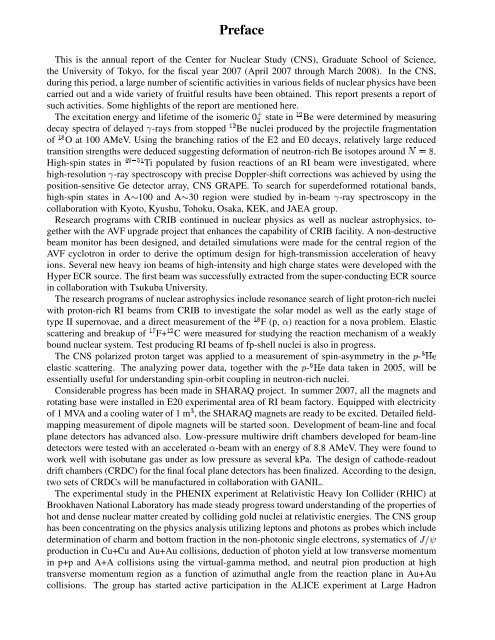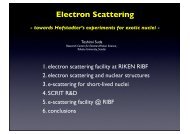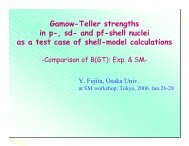Center for Nuclear Study,
Center for Nuclear Study,
Center for Nuclear Study,
You also want an ePaper? Increase the reach of your titles
YUMPU automatically turns print PDFs into web optimized ePapers that Google loves.
Preface<br />
This is the annual report of the <strong>Center</strong> <strong>for</strong> <strong>Nuclear</strong> <strong>Study</strong> (CNS), Graduate School of Science,<br />
the University of Tokyo, <strong>for</strong> the fiscal year 2007 (April 2007 through March 2008). In the CNS,<br />
during this period, a large number of scientific activities in various fields of nuclear physics have been<br />
carried out and a wide variety of fruitful results have been obtained. This report presents a report of<br />
such activities. Some highlights of the report are mentioned here.<br />
The excitation energy and lifetime of the isomeric 0<br />
decay spectra of delayed ¤ -rays from stopped ¢£¡ Be nuclei produced by the projectile fragmentation<br />
of ¢£¥ O at 100 AMeV. Using the branching ratios of the E2 and E0 decays, relatively large reduced<br />
¡ state in ¢£¡ Be were determined by measuring<br />
transition strengths were deduced suggesting de<strong>for</strong>mation of neutron-rich Be ¦¨§�© isotopes around ¢ .<br />
High-spin ������� states in Ti populated by fusion reactions of an RI beam were investigated, where<br />
high-resolution ¤ -ray spectroscopy with precise Doppler-shift corrections was achieved by using the<br />
position-sensitive Ge detector array, CNS GRAPE. To search <strong>for</strong> superde<strong>for</strong>med rotational bands,<br />
high-spin states in A� 100 and A� 30 region were studied by in-beam ¤ -ray spectroscopy in the<br />
collaboration with Kyoto, Kyushu, Tohoku, Osaka, KEK, and JAEA group.<br />
Research programs with CRIB continued in nuclear physics as well as nuclear astrophysics, together<br />
with the AVF upgrade project that enhances the capability of CRIB facility. A non-destructive<br />
beam monitor has been designed, and detailed simulations were made <strong>for</strong> the central region of the<br />
AVF cyclotron in order to derive the optimum design <strong>for</strong> high-transmission acceleration of heavy<br />
ions. Several new heavy ion beams of high-intensity and high charge states were developed with the<br />
Hyper ECR source. The first beam was successfully extracted from the super-conducting ECR source<br />
in collaboration with Tsukuba University.<br />
The research programs of nuclear astrophysics include resonance search of light proton-rich nuclei<br />
with proton-rich RI beams from CRIB to investigate the solar model as well as the early stage of<br />
type II supernovae, and a direct measurement of the ¢£¥ F (p, � ) reaction <strong>for</strong> a nova problem. Elastic<br />
scattering and breakup of ¢�� F+ ¢£¡ C were measured <strong>for</strong> studying the reaction mechanism of a weakly<br />
bound nuclear system. Test producing RI beams of fp-shell nuclei is also in progress.<br />
The CNS polarized proton target was applied to a measurement of spin-asymmetry in the � - ¥����<br />
elastic scattering. The analyzing power data, together with the � -�<br />
essentially useful <strong>for</strong> understanding spin-orbit coupling in neutron-rich nuclei.<br />
Considerable progress has been made in SHARAQ project. In summer 2007, all the magnets and<br />
rotating base were installed in E20 experimental area of RI beam factory. Equipped with electricity<br />
of 1 MVA and a cooling water of 1 m� , the SHARAQ magnets are ready to be excited. Detailed fieldmapping<br />
measurement of dipole magnets will be started soon. Development of beam-line and focal<br />
plane detectors has advanced also. Low-pressure multiwire drift chambers developed <strong>for</strong> beam-line<br />
detectors were tested with an accelerated � -beam with an energy of 8.8 AMeV. They were found to<br />
work well with isobutane gas under as low pressure as several kPa. The design of cathode-readout<br />
drift chambers (CRDC) <strong>for</strong> the final focal plane detectors has been finalized. According to the design,<br />
two sets of CRDCs will be manufactured in collaboration with GANIL.<br />
The experimental study in the PHENIX experiment at Relativistic Heavy Ion Collider (RHIC) at<br />
Brookhaven National Laboratory has made steady progress toward understanding of the properties of<br />
hot and dense nuclear matter created by colliding gold nuclei at relativistic energies. The CNS group<br />
has been concentrating on the physics analysis utilizing leptons and photons as probes which include<br />
determination of charm and bottom fraction in the non-photonic single electrons, systematics of �����<br />
production in Cu+Cu and Au+Au collisions, deduction of photon yield at low transverse momentum<br />
in p+p and A+A collisions using the virtual-gamma method, and neutral pion production at high<br />
transverse momentum region as a function of azimuthal angle from the reaction plane in Au+Au<br />
collisions. The group has started active participation in the ALICE experiment at Large Hadron<br />
��� data taken in 2005, will be





